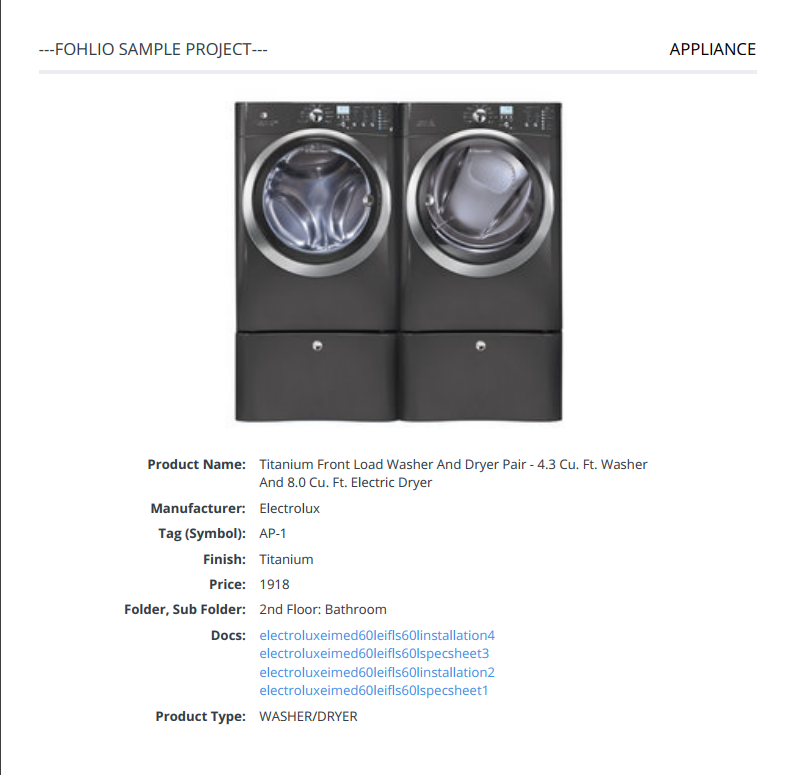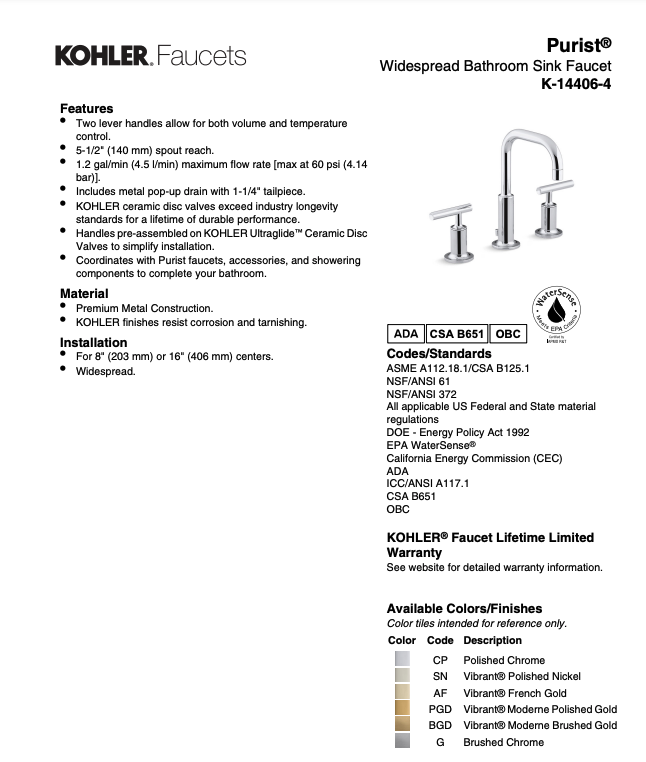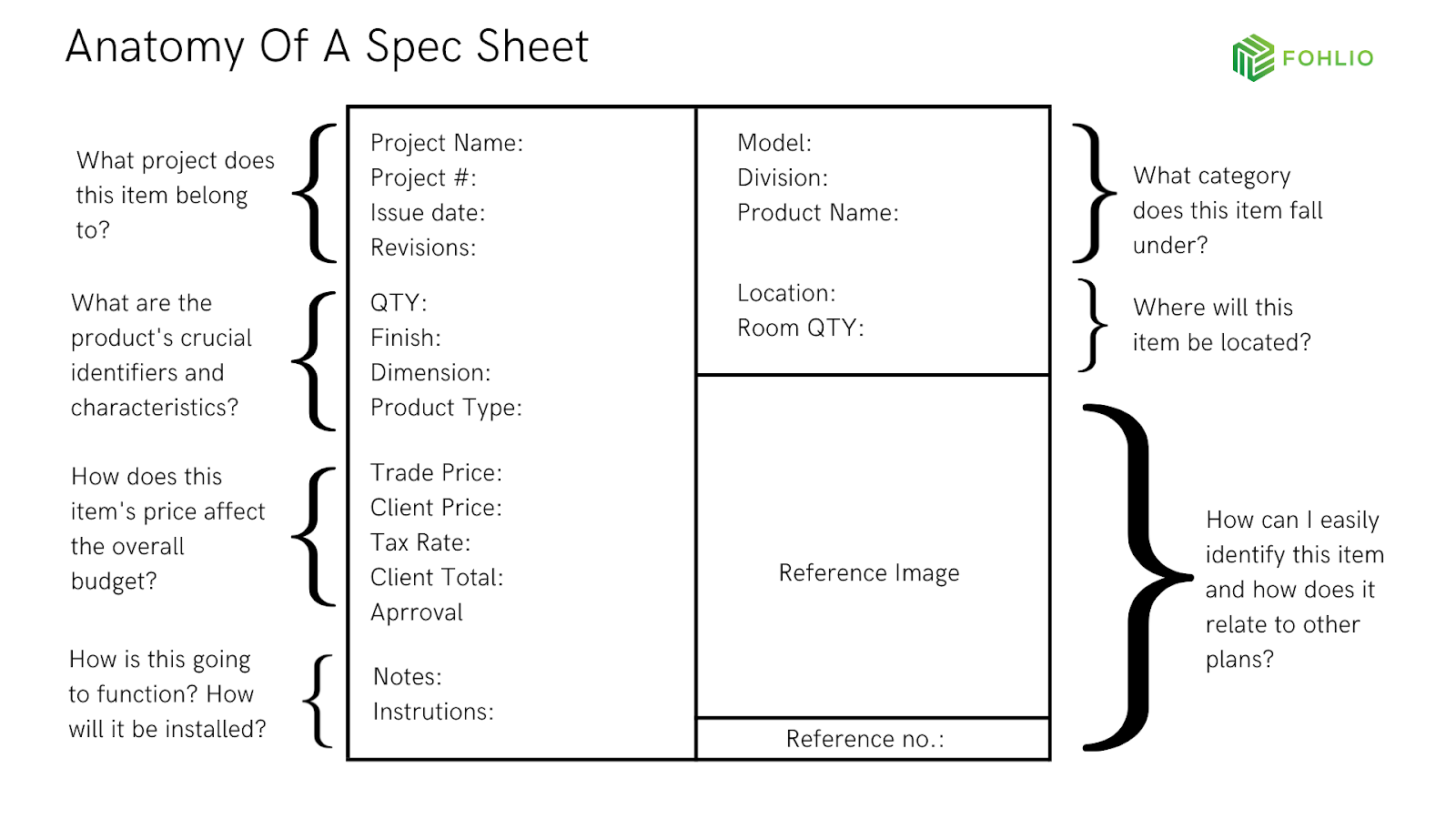How to Say Goodbye to Rework: 4 Ways to Streamline Specification and Procurement Data
Manage FF&E specification, procurement, and product data at scale. Take on bigger projects with confidence and grow your firm with Fohlio. Schedule a...

Specify and procure FF&E and OS&E at scale with Fohlio today. Empower teams to move faster and improve their operational workflow with specification, prototyping, procurement, collaboration, and analytics tools.
In overly simple terms, a spec sheet – short for specification sheet – is just a detailed description of a product. Spec sheets abound in manufacturing, construction, retail, and more.
For this article, we’re going to talk about spec sheets in the context of interior design specification and building construction.
If you’re new to FF&E, you might think spec sheets, design specs, cut sheets, and FF&E schedules all mean the same thing—or at least overlap. No worries: we’ll clarify how interior design specification fits into that picture, and how using the right interior design software makes the process faster and more accurate.
If you’ve been in the industry a while, there’s still plenty here for you. You’ll find tips on building professional interior design specification documents in minutes, examples of spec sheet templates from top brands, and insights into how interior design software streamlines collaboration between design and procurement teams.
Most importantly, you’ll learn best practices for turning FF&E documentation into a strategic advantage. With interior design software that connects directly to your specs, you can go beyond static pages of data and start creating actionable documentation that helps you:
Feel free to click on the topics that are most relevant to you.
Before we dive in, let’s quickly explore the differences between a spec sheet, a cut sheet, a schedule, and a specbook:
-1.png?width=1920&height=1080&name=Learn%20From%20the%20Best%20FF%26E%20Specification%20Templates%20(4)-1.png)
A spec sheet in FF&E (Furniture, Fixtures, and Equipment) is a document that provides a detailed description of an ff&e item or product. It is an essential part of the design process and plays a large part in the selection process.
The purpose of a spec sheet in interior design projects is to provide a comprehensive and detailed description of all the products, finishes, and materials used in the design. The spec sheet lists the product's dimensions, colors, textures, and other essential specifications required for the project. It also includes the manufacturer's name, product code, and price, allowing the designer to estimate the total cost of the project accurately.

Spec sheets play a crucial role in any interior design specification process. They serve as the backbone for communicating every material, finish, and furnishing detail across teams. With the right interior design software, designers can build and manage these spec sheets more efficiently—ensuring accuracy, consistency, and collaboration throughout the project.
Firstly, spec sheets act as a detailed reference for the designer, ensuring that products and materials align with the project’s creative vision and interior design specification standards. Secondly, they guide the selection of materials that meet performance criteria like durability, sustainability, and functionality—all of which can be tracked seamlessly within modern interior design software.
Thirdly, these documents serve as a long-term record of materials used in the project, making maintenance and future renovations more straightforward. When tied to interior design software, this data becomes searchable and reusable across multiple projects, saving time and reducing errors.
Ultimately, spec sheets are an essential part of the FF&E workflow and a key element of any interior design specification strategy. Supported by robust interior design software, they empower designers to deliver projects that are consistent, cost-effective, and true to the client’s vision.

In the context of ff&e specification, a product spec sheet is a document that provides a detailed description of the product's features, technical specifications, performance characteristics, and other essential details.
In other words, it's just a spec sheet. People sometimes just like to say "product spec sheet" instead of "spec sheet" even though they mean the same thing.
A product specification sheet is typically created by the manufacturer or supplier of the product and is often used by potential buyers, distributors, and specifiers to make informed purchasing decisions.

Part of a manufacturer-supplied product spec sheet. Image: Kohler
A product spec sheet can also be created by a designer or anyone involved in a design or construction project for different reasons: Maybe you're trying to have some ff&e items approved for purchasing or comparing two similar products to see which one provides a better value.
The purpose of a spec sheet for a product is to provide accurate and comprehensive information about the product's key features and specifications. This information is crucial for potential buyers to make informed purchasing decisions, especially when comparing different products from various manufacturers.
A typical product spec sheet includes several key sections:
A product specification sheet is a critical document that provides detailed information on a product's key features, technical specifications, and performance characteristics.
By providing this information to potential buyers, the spec sheet helps to ensure that the product meets the buyer's requirements and provides value for money.
In interior design ff&e specification, design specs refer to the detailed documentation that describes the design elements, standards, and requirements for the FF&E items to be used in a specific interior design project.
These design specs are created by interior designers and are used to ensure that the FF&E items selected for the project meet the project's design and functional requirements.
Design specs in FF&E specification typically include the following information:
Design specs are an essential part of FF&E specification in interior design projects. They ensure that the FF&E items selected for the project meet the designer's design and functional requirements, and are suitable for the project's intended use. Design specs also help to streamline the procurement process, ensuring that all parties involved in the project are working towards the same goals and objectives.
.png?width=1920&height=1080&name=Learn%20From%20the%20Best%20FF%26E%20Specification%20Templates%20(9).png)
Prescriptive specifications and performance specifications are two types of specifications that can be used in various industries, including interior design. Here are the differences between these two types of specifications:
Prescriptive specifications: Prescriptive specifications are also known as design specifications. They are highly detailed and describe precisely what materials, methods, and procedures must be used to achieve the desired outcome. They specify the exact size, shape, color, and other details of the materials to be used, as well as the installation methods to be followed. Prescriptive specifications leave little room for interpretation and are very specific in nature.
Performance specifications: Performance specifications focus on the outcome, rather than the method of achieving it. They specify the performance requirements that the final product must meet, without prescribing the materials or methods to be used. Performance specifications allow for flexibility and innovation, as long as the final product meets the desired performance requirements.
Now, why are specifications relevant to interior design? It's because they provide a detailed description of the design elements, materials, and standards required for a specific project. They ensure that all stakeholders involved in the project are working towards the same goals and objectives, and that the project meets the client's requirements.
Specifications help interior designers to:
Specifications are essential in interior design as they ensure that the project meets the designer's design and functional requirements, comply with regulations and standards, and streamline the procurement process. Prescriptive specifications and performance specifications are two types of specifications that can be used in interior design, with each having its advantages and disadvantages.
Spec sheets play an essential role in helping hotels and retail stores adhere to interior design brand standards by providing detailed information about the materials, finishes, and FF&E items that must be used in a specific interior design project. Here are some ways that spec sheets help hotels and retail stores adhere to interior design brand standards:
Learn more: How FF&E is Bringing Hospitality Design Trends to Life
Spec sheets help hotels and retail stores adhere to interior design brand standards by providing detailed information on the materials, finishes, and FF&E items that must be used in a specific project.
By following the specifications provided in the spec sheets, hotels and retail stores can ensure that their properties are consistent with the brand's overall design scheme, meet the required design and functional requirements, and enhance the guest experience.
Learn more: How to Build FF&E Brand Standards: An In-Depth Guide
On the surface, creating a product spec sheet is straightforward: You just list everything there is to know about a particular ff&e product.
However, “everything” can be quite a lot. It might also not include information related to your project’s context.
As a general rule, you’ll want to include the following information in your product specification sheet:

An effective FF&E spec sheet should include detailed information about the FF&E items to be used in the project, including product information, material and finish, size and dimensions, quantity and cost, sustainability and safety, images and drawings, installation information, and warranty information.
-1.png?width=1920&height=1080&name=Learn%20From%20the%20Best%20FF%26E%20Specification%20Templates%20(5)-1.png)
Another consideration when creating a product specification sheet is that different stakeholders need different pieces of information. Designers, for example, will be more interested in details pertinent to brand standards: Colors that adhere to brand visuals, sustainability features that support brand values, etc.
On the other hand, the ff&e procurement team will care more about which suppliers the products are coming from, how much they cost, and what lead times they can promise.
Technically, you can create the same product spec sheet for everyone involved – but curated information makes the documents more effective. Curated spec sheets help stakeholders stay focused on their work. They also save time by eliminating the need to sift through unnecessary information to find what they need.
There’s a tradeoff though: Spec sheets customized to stakeholders take time and effort.
So the question becomes: Do you want easy spec sheet creation or an effective document?
The good news is that you don’t have to choose. By creating a digital materials library, you can keep all your ff&e product information in one place, organized and easily accessible.
Besides product details and pricing, another piece of information you might find useful is an item’s history. How has it performed in the past? After you installed it at another location five years ago, how long did it take before you had to replace it?
Answers to these questions will help you decide whether it’s worth specifying and purchasing again. You can even compare the same material’s performance between different locations to see if it’s universally optimal.
Historical knowledge is also invaluable when it comes to managing relationships with suppliers. Knowing exactly how much business you’ve given a specific vendor in the past can be a lever you can pull when negotiating better terms and bigger discounts.
Thing is, you can’t take advantage of historical data if your spec sheets are static.
Which brings us to the question of how to keep spec sheets updated. When we think of a product spec sheet, we visualize a printout or a PDF.
I believe it’s time to rethink this. Instead of constantly wrangling spec sheets, we should make it the industry standard to manage ff&e product data in a digital materials library. Having a platform like this allows your team to have a living, evolving database that grows smarter over time.
An online materials library also makes it easier and more efficient to keep all your stakeholders in one place and on the same page.
With a cloud-based platform, you can simply record every time there’s an update to an ff&e item. You can then go over this information whenever you want.
A flexible online materials library will also allow you to generate custom spec sheets and reports in minutes. That’s because all your data is already in one place and you can set up templates outlining the necessary information for each stakeholder.
A cut sheet is similar to a spec sheet in that it provides crucial information about an ff&e product, but with a few distinct differences.
A cut sheet is a document that provides detailed information about the dimensions, materials, and installation instructions for custom-designed FF&E items. Here are some items that should be included in a cut sheet, along with best practices for creating one:
Best practices for creating a cut sheet include:
An effective cut sheet should include detailed information about the custom-designed FF&E item, including dimensions, materials, finish, construction details, installation instructions, and safety precautions. By following best practices for creating a cut sheet, you can ensure that the FF&E item is constructed and installed correctly, and meets the project requirements.
An FF&E (Furniture, Fixtures, and Equipment) schedule is a document that outlines all the items that need to be purchased, installed, and delivered for an interior design project. Here are some items that should be included in an FF&E schedule, along with best practices for creating one:
Best practices for creating an FF&E schedule include:
The ideal FF&E schedule should include detailed information about each item, including the manufacturer, model number, quantity, delivery and installation dates, location, and budget. By following best practices for creating an FF&E schedule, you can ensure that the FF&E items are delivered and installed correctly, and that the project stays on schedule and within budget.
An ideal FF&E (Furniture, Fixtures, and Equipment) specbook should be a comprehensive and detailed document that includes all the necessary information about the FF&E items that will be used in a specific interior design project. The purpose of the specbook is to ensure that all items are specified correctly and to help project managers, designers, and contractors to understand the design intent and requirements.
Here are some key elements of an ideal FF&E specbook:
An ideal FF&E specbook should be a comprehensive and detailed document that includes all the necessary information about each FF&E item that will be used in an interior design project. The specbook should be well-organized, easy to use, and consistent and accurate in its item descriptions, specifications, and pricing information.
When you’re managing hundreds of finishes, fixtures, and equipment items, having a strong interior design specification process keeps every detail consistent. The right interior design software takes that even further—it ensures your spec sheets aren’t just static documents but living tools for collaboration.
An accurate interior design specification defines materials, vendors, and pricing, but interior design software brings those specs to life—automating updates, tracking revisions, and linking data across teams. Together, they form the foundation for standardizing how designers build and manage spec sheets.
With the right system in place, your interior design specification process flows directly into procurement and installation. And when powered by interior design software, it becomes scalable, searchable, and error-proof—transforming your spec sheets into a central hub for decision-making and documentation.
When reading through all these definitions and descriptions of spec sheets, specbooks, schedules, and cut sheets, you can see that there’s a ton of overlap with the information that each of them provide.
However, the common thread is that not only should your ff&e documentation be thorough – you would ideally also provide the right information at the right time to the right people. It’s also important to keep your end goal in mind whenever you create any documentation – you want it to be actionable. And that’s a lot of work but it’s more than doable.

Get in touch with our product experts today to learn how.
Specify and procure FF&E and OS&E at scale with Fohlio today. Empower teams to move faster and improve their operational workflow with specification, prototyping, procurement, collaboration, and analytics tools.
Learn how to:
Manage FF&E specification, procurement, and product data at scale. Take on bigger projects with confidence and grow your firm with Fohlio. Schedule a...
Manage FF&E specification, procurement, and product data at scale. Take on bigger projects with confidence and grow your firm with Fohlio. Schedule a...
Manage FF&E specification, procurement, and product data at scale. Take on bigger projects with confidence and grow your firm with Fohlio. Schedule a...